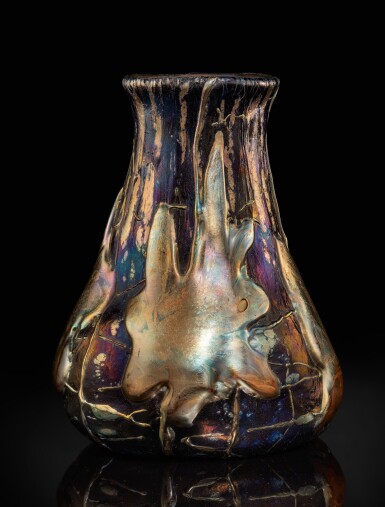Dreaming in Glass: Masterworks by Tiffany Studios
Dreaming in Glass: Masterworks by Tiffany Studios

Property from the Estate of a Private Collector, New York
TIFFANY STUDIOS | "LAVA" VASE FROM THE ALASKA-YUKON-PACIFIC EXPOSITION
Auction Closed
December 12, 11:00 PM GMT
Estimate
80,000 - 120,000 USD
Lot Details
Description
Property from the Estate of a Private Collector, New York
TIFFANY STUDIOS
"LAVA" VASE FROM THE ALASKA-YUKON-PACIFIC EXPOSITION
circa 1906-1907
favrile glass
engraved Alaska Yukon Ex./3751C L. C. Tiffany-Favrile
7½ in. (19.1 cm) high
Paul Doros, The Tiffany Collection of the Chrysler Museum at Norfolk, Norfolk, VA, 1978, pp. 53-54, nos. 65-66 (for a related “Lava” vase and bowl)
Alastair Duncan, Martin Eidelberg and Neil Harris, Masterworks of Louis Comfort Tiffany, London, 1989, p. 101 (for a related vase)
Alastair Duncan, Fin de Siècle Masterpieces from the Silverman Collection, New York, 1989, p. 49 (for a related vase)
Robert Koch, Louis C. Tiffany: The Collected Works of Robert Koch, Atglen, PA, 2001, p. 108 (for a related vase)
There is a legend that Louis Tiffany was inspired to create "Lava" vases after visiting Sicily and seeing Mount Etna erupt. This story is most likely apocryphal as none of the volcano’s eruptions coincide with any of his many trips to Europe. It is far more likely that Tiffany was influenced by 17th Century Japanese raku-fired ceramic tea bowls. He was an avid collector of Japanese objects, and it is no surprise that some of the earliest pieces of blown Favrile glass were compared to “those freakish little things made nowadays in Japan of a rough-textured, strong pottery…that strike one far more as grotesque than beautiful.”
Lava vases are intriguing as they were perhaps the only type of blown Favrile glass that required an extended period of development until the glassmakers were able to perfect the style and achieve the necessary technical skills to produce them. Unlike flower forms and paperweight-technique vases that took the glasshouse only a year or two to perfect, Lavas evolved over a ten to twelve-year period. Considering the length of time required to achieve the desired decorative effect, it is surprising that Lava vases, featuring heavy irregular iridescent gold drippings over a textured dark navy ground, were produced by Tiffany Furnaces for only two brief periods: circa 1906-1907 (the first known example was displayed at the 1906 Paris Salon) and again around 1916.
The exceptional piece offered here is similar to two known Lava vases, one in the permanent collection of the Chrysler Museum of Art (Norfolk, VA), numbered 2584C, and the other last being offered in these salesrooms on December 13, 2017 (lot 227) and inscribed 4056C. The shape and decoration of this piece, however, is superior to both of those examples. The slightly balustered body, of transparent yellow glass, has an irregular textured navy overlay. This is beautifully contrasted by the irregular applied drippings and trailings, as well as the openings to the overlay, that received a bright gold iridescence. The iridescent gold “flowers” are also highly unusual and visually striking. Normally comprised of the same transparent yellow glass as the body, these applied sections have subtle translucent internal swirls that adds to the three-dimensionality of the flowers.
It is significant that this vase was selected to be exhibited at the 1909 Alaska-Yukon-Pacific Exposition held in Seattle, Washington. Tiffany’s exhibition was valued at $75,000 at the time, the equivalent of over $2 million today, and was intended to visibly demonstrate to the world why Favrile “glass is regarded as the highest development of the glassblowers’ art, excelling in richness of coloring.”1 This vase, truly worthy of being seen and admired by the exposition’s international audience, clearly reflects the incredible mastery the glassworkers worked so tirelessly to achieve. Lava vases perhaps best typify the experimental decorative “accidents” Tiffany inspired, and expected, his men to attempt. Vases such as this one convincingly support Louis Tiffany’s claim that his blown glass objects were unique and beautiful works of art, equal to any painting or sculpture.
PAUL DOROS
Former curator of glass at the Chrysler Museum (Norfolk, Virginia) and author of The Art Glass of Louis Comfort Tiffany (New York: Vendome Press), 2013
1“Fragile Glass Exhibit,” The (Walla Walla, WA) Evening Statesman, March 27, 1909, p. 5.
